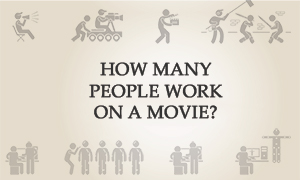 I have been contacted by a number of readers asking how many people have lost work due to the cancellation of film productions.
I have been contacted by a number of readers asking how many people have lost work due to the cancellation of film productions.
Sadly, the complexity of the industry means I cannot calculate the exact number of people unemployed. However, it is possible to look at how many people would typically work on a feature film. I built a dataset of all movies released in the US between 2000 and 2018 and studied the number of crew credits.
How many people work on a film?
Between 2000 and 2018, the average film released in North American cinemas employed 276 people in crew roles. This covers development, pre-production, shooting and post-production.
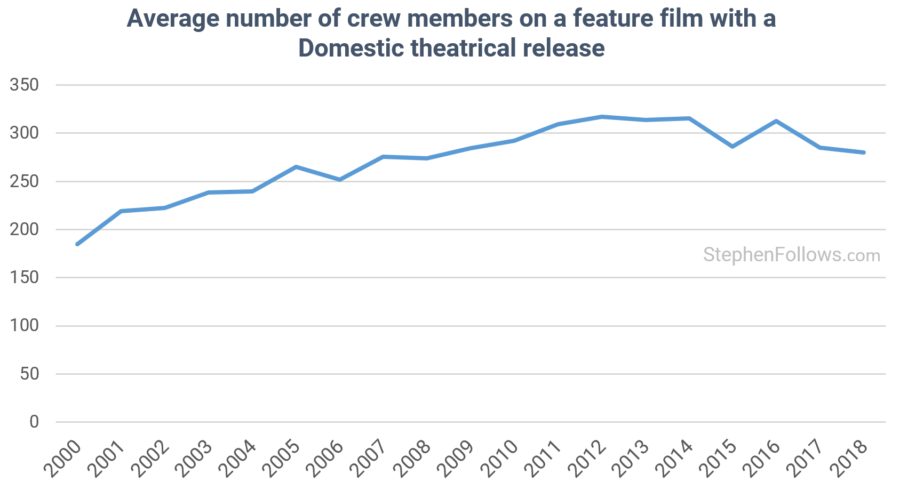
Over the past two decades, the number of crew members on a film has increased by 51%, from 185 in 2000 to 280 in 2018. However, this change has not been uniform. Perhaps the starkest change has been in the different trends between Special Effects jobs (i.e. physical effects such as rain, wind, and explosions) and Visual Effects jobs (computer-based effects).
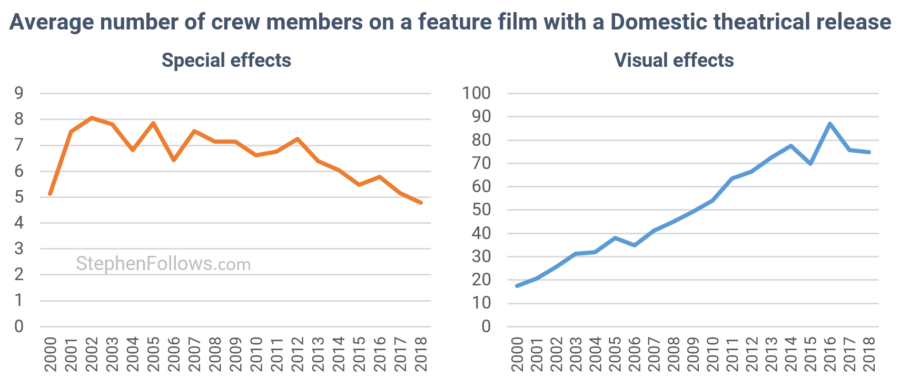
How wide is the range of employment numbers?
A common theme in film data analysis is power laws. A small percentage of movies make most of the money, a small number of people hold most of the power, etc. In this case, it means that a small number of big productions disproportionately employ a large number of people.
The chart below shows all the 8,095 films I studied, sorted by the number of crew members who worked on them. Half of all productions credited fewer than 168 people, but just 92 productions (i.e. 1.1% of all movies produced) provided 10% of credits.
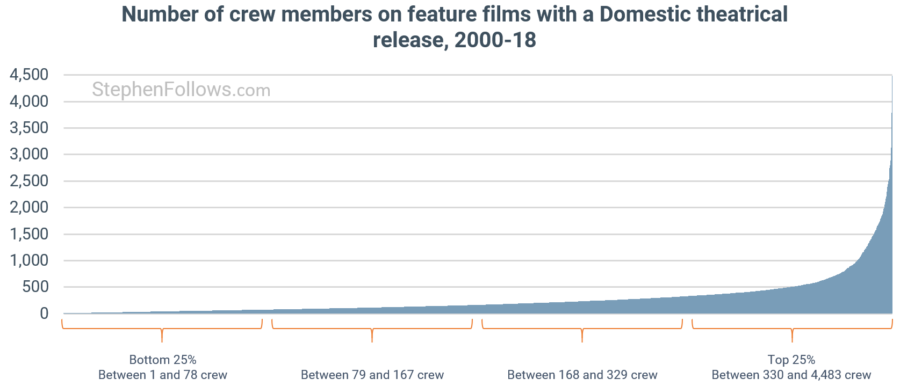
Which films employed the most people?
Overall, the number of crew members credited on a movie is strongly linked to the film’s budget, with a Pearson correlation of 0.89 (where zero means no correlation and one means a perfect correlation).
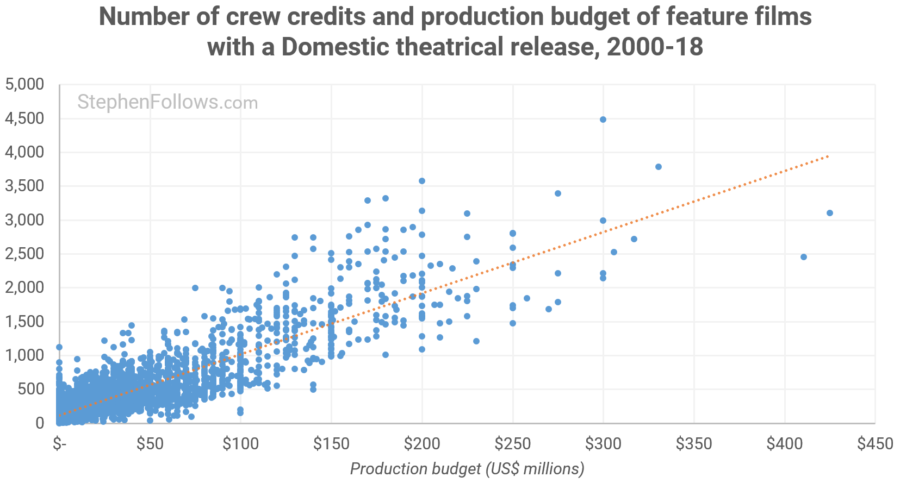
The movies with the greatest number of crew credits were Marvel movies, with the studio accounting for eight out of the ten top films. In fact, 4.3% of all movie credits between 2007 and 2018 were on films produced by Marvel Studios.
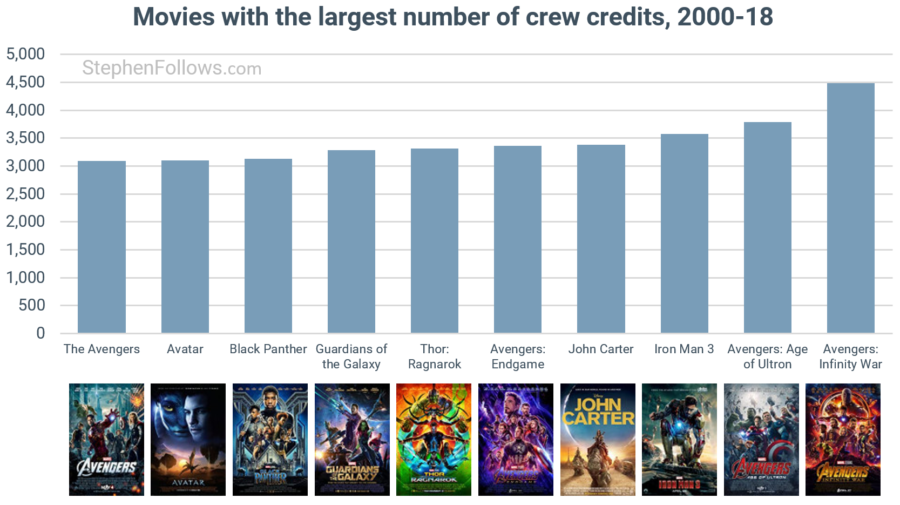
Further reading
If you’ve enjoyed this article then you may enjoy these related pieces:
- Who are the most prolific people working in Hollywood?
- How has the average Hollywood movie crew changed?
- Do more film crew members work on-set or in post-production?
- How many screenwriters does it take to write a movie?
- How many stunt performers work on a movie?
- How many Assistant Directors work on UK and US movies?
- How many editors does it take to edit a movie?
- What is happening to Second Unit Directors?
- How many films does the average director make?
- On average, how many films does a producer produce?
Notes
Today’s research is looking at feature films which were released in North American cinemas between 1st January 2000 and 31st December 2018. My data for today’s research comes from IMDb, Wikipedia and other public sources. There are a few things to bear in mind with this research:
- The data goes up to 2018 as credits can take time to appear in their entirety online. This means that some of the films released in 2019 still have incomplete credits lists. That said, there is no reason to think that 2019 was atypical and so we can expect to see similar results to 2018 and for general trends to have continued.
- When referring to “crew” I am not including actors or background artists.
- This tracks people and credits, not hours/days worked. Someone may work just one day on a production while another works for months – each only receiving one credit apiece.
- Movie credits are not always complete, with some sectors like visual effects suffering from caps on the number of people who can receive a credit, no matter how many actually worked on a film. I have studied this topic in detail in the past – How many movies credits go uncredited?
- In recent years, Studios have started adding notes towards the end of movie credits which estimate how many jobs were connected to the film. The first was Taken 2 which included this line in the final credits roller: “The making and legal distribution of this film supported over 14,000 American jobs and involved over 600,000 work hours“. I haven’t used these calculations in today’s research as they fall more into the category of PR than data science. For example, another Fox film that same year, Life of Pi, used the exact same statement and numbers.
Epilogue
My research is looking at direct jobs, by way of movie credits. There are many more people who will support the release of a film who do not receive direct credits, such as those in marketing, distribution and within the corporate structures of the companies involved. Then there are also people whose jobs depend on the people working on films, such as suppliers of raw materials for art departments, manufacturers and hiring houses for equipment, journalists on trade publications, etc, etc.
In the US, IATSE guilds (representing cinematographers, editors, production designers and sound professionals) say that 120,000 jobs will be lost due to the pandemic. Taking the widest view possible, the MPPA says “In the United States alone, the film, television, and streaming industry supports 2.5 million jobs“.
In the UK, the union BECTU estimates that 50,000 industry freelancers will have lost their jobs due to the pandemic. A recent BECTU survey found that 71% of creative industry freelancers are afraid that they will not be able to cover all their bills due to the pandemic. And this pattern is likely to be repeated in all countries with film sectors.
Finally, it’s worth remembering that “just” one job may be supporting a whole family. Film jobs are typically uncertain at the best of times and recent events have shown just how hard it can be to be a freelancer. Hopefully, we will all be able to weather the lockdown and get back to work soon.


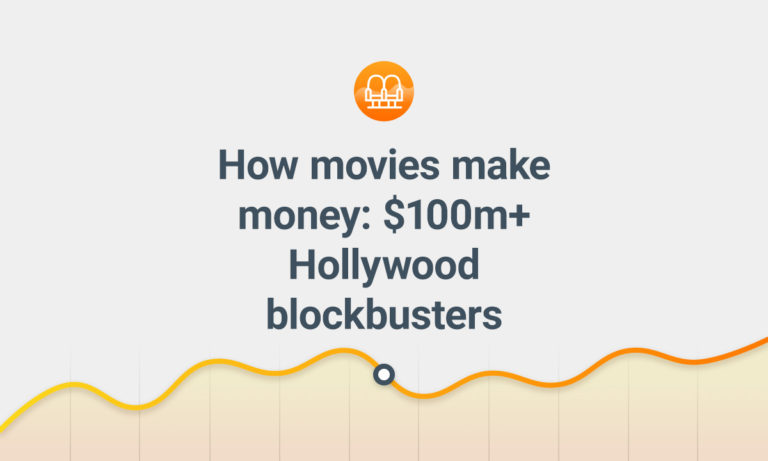


Comments
I really enjoyed these visualizations. I had no idea some movies employ even more than 300 people. I think your data analyses are one of the best ways to understand the movie industry. Thank you for sharing them with us.
Hi,
Can you please tell us,
what are differences between this link and your another link ?: https://stephenfollows.com/how-many-people-work-on-a-hollywood-film/.
It seems to me that both links show different figures.
Cheers,
Muhamad